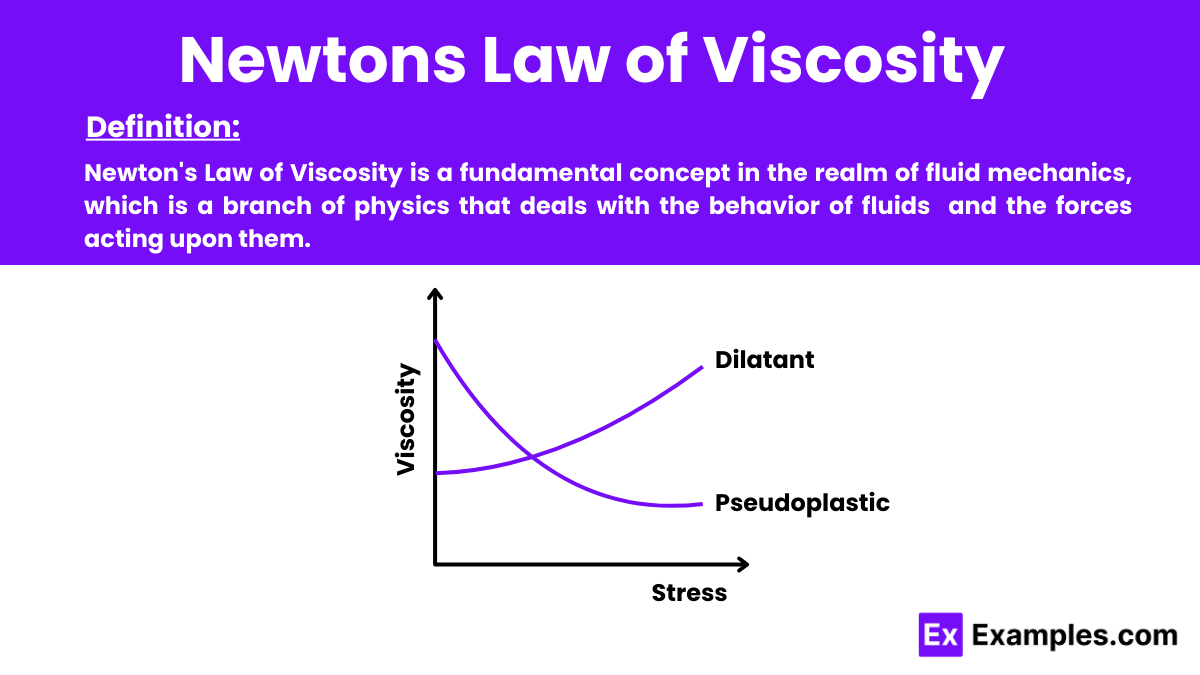What is Newton's Law of Viscosity?
The relationship between force and mass
The relationship between shear stress and shear rate
The relationship between velocity and displacement
The relationship between temperature and pressure


Newton’s Law of Viscosity is a fundamental concept in the realm of fluid mechanics, which is a branch of physics that deals with the behavior of fluids (liquids and gases) and the forces acting upon them. This law provides a quantitative description of the flow of fluids, and it is essential for understanding how viscous forces are characterized in various physical situations.
The formula for Newton’s Law of Viscosity is expressed as:
where:
Fluids, substances that can flow and conform to the shape of their containers, play critical roles in both natural and industrial processes. They are primarily categorized based on their ability to resist shear stress and their viscosity behavior under varying conditions. Understanding the different types of fluids is essential for fields such as engineering, meteorology, and various scientific research areas.
Newtonian fluids exhibit a constant viscosity regardless of the applied shear rate. Their shear stress is directly proportional to the shear rate, making their behavior predictable and consistent under different flow conditions. Common examples include water and most gases, which are staples in countless applications across industries.
Non-Newtonian fluids do not have a constant viscosity; their viscosity can change when under force to either increase or decrease, depending on the type. They are further divided into several subcategories:
Ideal fluids are hypothetical and do not exhibit viscosity or compressibility. They are used in theoretical physics to simplify the analysis of fluid dynamics by removing complex variables from the equations. While not practical in real-world applications, they provide essential insights into fluid behavior under idealized conditions.
Real fluids, which include all fluids in nature and industry, exhibit viscosity. They are the opposite of ideal fluids, facing resistance due to their viscosity, which impacts their flow and behavior under various physical conditions.

Newton observed that the viscous force in fluids is proportional to the velocity gradient perpendicular to the flow direction.
No, Newton is not a unit of viscosity. The unit of dynamic viscosity is the Pascal-second (Pa·s).
In 3D, Newton’s law states that the stress tensor is proportional to the velocity gradient tensor, modeling more complex flow dynamics in fluids.
Text prompt
Add Tone
10 Examples of Public speaking
20 Examples of Gas lighting
What is Newton's Law of Viscosity?
The relationship between force and mass
The relationship between shear stress and shear rate
The relationship between velocity and displacement
The relationship between temperature and pressure
What is the formula representing Newton's Law of Viscosity?
τ = μ(dv/dy)
F = ma
P = F/A
V = IR
In the formula τ = μ(dv/dy), what does μ represent?
Shear stress
Velocity gradient
Dynamic viscosity
Pressure
Which unit is used to measure dynamic viscosity in the SI system?
Pascal
Newton-second per meter squared (Ns/m²)
Joule
Watt
If the dynamic viscosity of a fluid is high, what can be said about its flow?
It flows easily
It resists flow
It has a low shear stress
It has a high velocity gradient
What does a linear relationship between shear stress and shear rate indicate about a fluid?
The fluid is compressible
The fluid is a Newtonian fluid
The fluid is an ideal gas
The fluid is a non-Newtonian fluid
What happens to the shear stress if the dynamic viscosity of a fluid is doubled and the velocity gradient remains the same?
It remains the same
It is halved
It is doubled
It is quadrupled
What is the physical interpretation of the velocity gradient (dv/dy) in Newton's Law of Viscosity?
The rate of change of velocity with respect to distance
The pressure difference in a fluid
The temperature difference in a fluid
The density change in a fluid
Which of the following is not a characteristic of a Newtonian fluid?
Constant viscosity
Linear relationship between shear stress and shear rate
Viscosity changes with shear rate
Obeys Newton's Law of Viscosity
How does temperature typically affect the viscosity of a liquid?
Increases viscosity
Decreases viscosity
Does not affect viscosity
Increases viscosity to a certain point, then decreases
Before you leave, take our quick quiz to enhance your learning!

